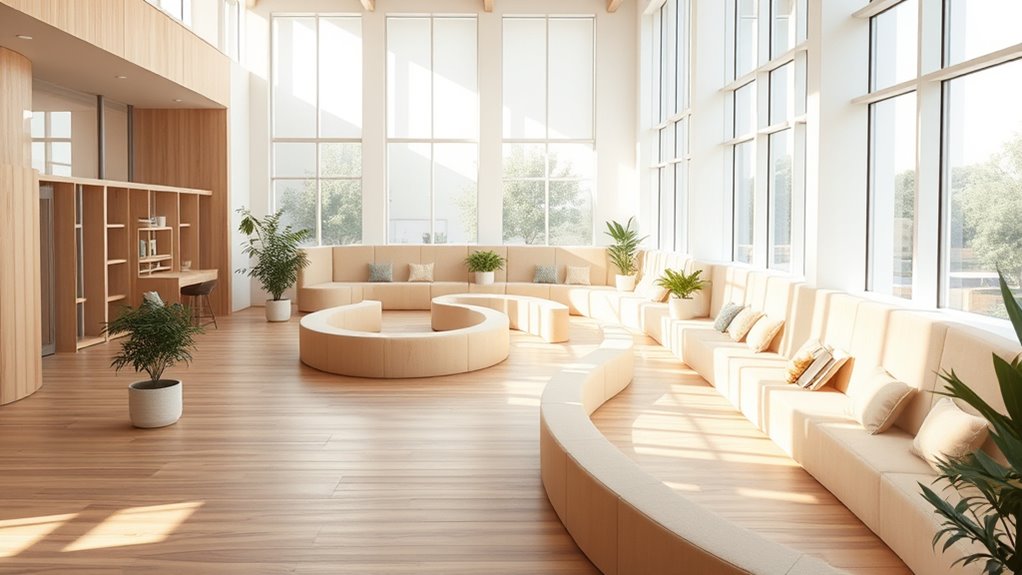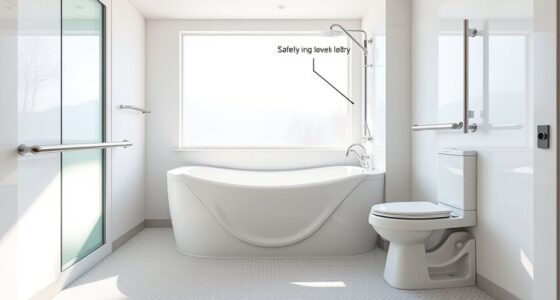To create safe indoor wandering paths, focus on designing open, clutter-free routes that guide movement naturally. Arrange furniture to form clear corridors, use visual cues like contrasting colors or patterns, and install soft cushioning mats. Keep pathways well-lit and free of hazards like loose rugs or sharp edges. Add safety features such as handrails and non-slip mats where needed. For more ideas on blending safety with seamless exploration, keep exploring how to promote a secure, inviting environment.
Key Takeaways
- Use visual cues like color contrasts and patterns to subtly guide movement along desired paths.
- Arrange furniture to create open, unobstructed routes that encourage natural wandering.
- Install safety features such as handrails and non-slip mats to ensure stability without limiting movement.
- Remove clutter and secure loose rugs to prevent trips, maintaining clear pathways for exploration.
- Incorporate lighting and signage to enhance visibility and communicate safe routes without restricting flow.

Finding safe wandering paths indoors is essential to prevent accidents and guarantee a comfortable environment. When you create designated routes within your home, you help reduce the risk of trips, falls, and other mishaps, especially for children, elderly family members, or anyone prone to accidents. The goal isn’t to restrict movement entirely but to guide it naturally, allowing your loved ones to explore freely while maintaining safety. Think of it as designing a flow that encourages exploration without chaos or hazards.
Start by identifying high-traffic areas and potential hazards. Clear pathways of clutter, loose rugs, or furniture edges that could cause someone to trip. Use simple markers like rugs, tapes, or furniture arrangements to define walking zones clearly. Light these paths well; good lighting makes a huge difference in preventing accidents, especially at night. You don’t need elaborate fixtures—just enough illumination to keep the area visible and inviting. Consider placing night lights in hallways and bathrooms to make nighttime navigation safer.
Arrange furniture to create open corridors, ensuring there’s enough space for movement. Avoid blocking doorways or hallways with bulky furniture, so people can traverse comfortably without feeling confined. If you have children or pets, create dedicated zones where they can move freely without risking injury. Open spaces can be decorated with soft mats or carpets that provide cushioning if someone falls, making the environment safer and more inviting. Use visual cues like color contrasts or patterns to subtly guide movement without making the space feel restrictive. Incorporating thoughtful layouts and mindful design can also promote better space utilization and flow within your home.
Incorporate safety features such as handrails along staircases or in slippery areas like bathrooms. These supports provide stability and confidence for those who need it. Non-slip mats and adhesive strips on slippery surfaces are inexpensive yet effective ways to prevent falls. For areas prone to moisture, like kitchens and bathrooms, ensure ventilation and quick-drying mats to reduce slipping hazards.
Finally, communicate your intentions clearly. Use signage if needed to indicate stairs, slippery zones, or areas under maintenance. Keep pathways unobstructed and encourage family members to maintain the flow by putting things back in their designated places. Creating a safe indoor wandering path isn’t about limiting your freedom of movement; it’s about designing a space where movement is effortless, safe, and natural. By thoughtfully planning and maintaining these routes, you foster an environment where everyone can move confidently, explore freely, and feel secure in their surroundings.
Frequently Asked Questions
How Can I Encourage Spontaneous Indoor Movement Safely?
You can encourage spontaneous indoor movement by creating inviting, open spaces that naturally attract exploration. Use engaging visuals, varied textures, and interesting objects to spark curiosity. Keep pathways clear and unobstructed so movement feels effortless. Incorporate playful elements like soft mats or stepping stones. Offer opportunities for different types of activity, like dancing or crawling, ensuring safety with non-slip surfaces and secure furniture to prevent accidents while encouraging free, joyful exploration.
What Are the Best Materials for Non-Slip Wandering Paths?
You should choose non-slip materials like rubber mats, textured vinyl, or cork for wandering paths. These materials provide excellent grip, reducing falls and ensuring safe movement. Avoid smooth surfaces like polished wood or tile alone, unless combined with non-slip treatments. Opt for options that are durable, easy to clean, and comfortable underfoot. By selecting the right materials, you create a safe environment that encourages spontaneous indoor wandering without risking slips.
How to Balance Safety and Freedom in Indoor Wandering Spaces?
You can balance safety and freedom in indoor wandering spaces by creating clear, open pathways that invite exploration while adding non-slip surfaces to prevent falls. Use gentle curves instead of sharp turns to encourage natural movement, and incorporate varied textures to stimulate senses. Guarantee ample lighting and remove clutter, allowing your loved ones to move freely without feeling confined. Regularly assess the environment for hazards, maintaining a safe yet liberating space for wandering.
Are There Specific Design Tips for Small Indoor Areas?
In small indoor spaces, use narrow, curved pathways to gently guide movement without feeling restrictive. Incorporate visual cues like colorful rugs or distinctive furniture to create natural routes, and keep clutter minimal to prevent obstacles. Use lighting strategically to highlight safe walking areas, and add low, soft barriers or planters to subtly define paths. These tips help you encourage free movement while maintaining safety and a sense of openness.
How Can Technology Enhance Safe Indoor Wandering Experiences?
You can enhance safe indoor wandering by using technology like motion sensors, smart lighting, and GPS tracking. These tools help you monitor movement, prevent accidents, and create responsive environments that adapt to your needs. Automated lights guide you along safe paths, while wearable devices alert you to potential hazards. Incorporate these technologies to promote freedom of movement while ensuring safety, making indoor wandering both enjoyable and secure.
Conclusion
Creating safe wandering paths indoors isn’t about restricting movement but guiding it thoughtfully. Some believe that open spaces promote freedom, but evidence shows that well-designed routes can actually reduce accidents and anxiety. When you channel movement with clear pathways and safe zones, you encourage exploration while minimizing risks. So, instead of limiting your space, consider how intentional design can foster both independence and safety—proving that the right layout truly makes all the difference.









